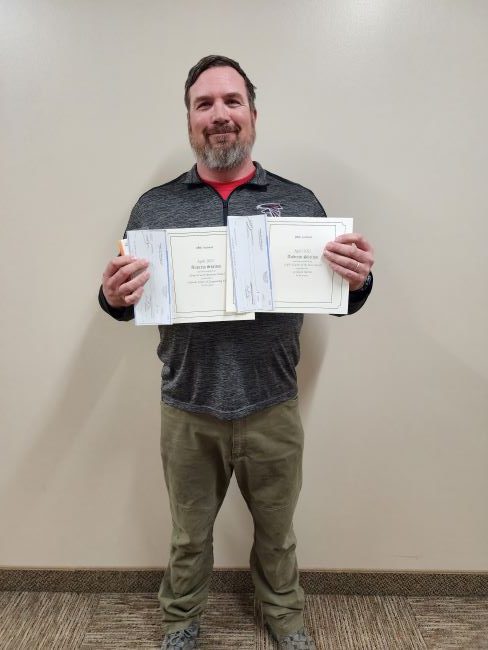Student Researcher Information
All students (with individual & team projects) who wish to participate in the Colorado Science & Engineering Fair must:
- be a 6th – 12th grade student in a Colorado public, private, parochial, home or on-line school; and
- participate in only one Regional Science Fair located in the county where they go to school (or live if home-schooled); and
- be chosen by their Regional Science Fair to represent that region at the CSEF; and
- abide by all International Science & Engineering Fair, CSEF and Regional Science Fair rules, regulations and policies that currently exist regarding pre-college science and engineering research.
The Colorado Science & Engineering Fair is affiliated with the Regeneron International Science & Engineering Fair (ISEF). For this reason, all students participating in the CSEF must adhere to the international rules and guidelines set forth by the Society for Science’s Scientific Review Committee. These rules outline the forms, levels of supervision, and risk assessments that are required for all projects as well as those that involve human subjects, vertebrate animals, potentially hazardous biological agents and hazards chemicals, devices and activities.
Please remember that these rules are in place to ensure the safety of the student researcher as well as the subjects (human or animal) that they may be working with in their study. They are NOT trivial and are based on what working scientists must adhere to as well as federal laws and regulations.
Questions about these rules and guidelines can be directed to the CSEF Scientific Review Committee or the ISEF Scientific Review Committee at any time.
Below are links to the requirements for high school students (middle school students can also opt to use these ISEF forms). You can also download the complete ISEF 2025 Rules & Guidelines Booklet.
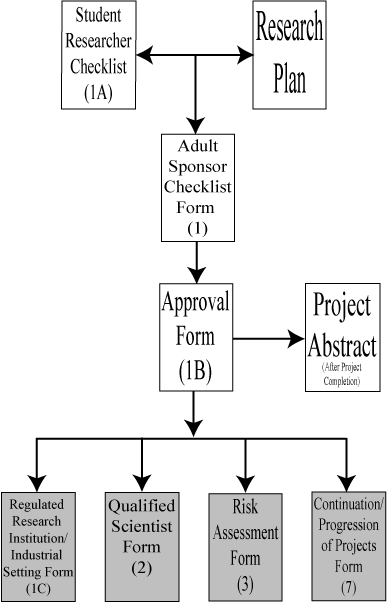
Form 1 – Checklist for Adult Sponsor
This form should be done once the Student Checklist (1A) and Research Plan are near completion. Please note that the Adult Sponsor should sign and date this form according to the date of REVIEW and APPROVAL and not the date of signature. This is useful if the students have research notebooks and the teacher reviews and initials those before transferring everything to the forms.
For additional help in completing Form 1, watch the Form 1 Help Video.
Form 1A – Student Checklist
This form should be completed in conjunction with the Research Plan. On this form, students should outline details about when and where the experimentation will take place.
**NOTE** If a student wishes to continue collecting data between competitions (i.e., after the Regional Science Fair and before CSEF), then a research amendment form should be completed indicating a new anticipated end date.
For additional help in completing Form 1A, watch the Form 1A Help Video.
Research Plan
This should be typed and completed in conjunction with the Student Checklist Form (1A). It must be a detailed account of what the student(s) anticipate doing in the experimental portion of the project.
Any project dealing with Human Subjects, Vertebrate Animals and/or Potentially Hazardous Biological Agents (i.e., microorganisms, bacteria, etc.) MUST be reviewed by an Institutional Review Board and/or Scientific Review Committee prior to any experimentation beginning.
Form 1B – Approval Form
This form should be completed once the Student Checklist, Research Plan, Checklist for Adult Sponsor and any other needed forms for the type of project are all completed. Sections 1 & 2a (if applicable) must be signed prior to experimentation. Sections 3 & 2b (if applicable) will be signed just prior to a student competing in a regional science fair.
For additional help in completing Form 1B, watch the Form 1B Help Video.
Form 1C – Regulated Research Institutional/Industrial Setting
This form is completed AFTER experimentation is completed at a research institution (RRI) or an industrial setting by the student’s mentor.
For additional help in completing Form 1C, watch the Form 1C Help Video.
Form 2 – Qualified Scientist
This form is completed PRIOR to experimentation by a Qualified Scientist having the following qualifications:
- Earned a doctorate/professional degree in a scientific field related to the student’s area of research AND/OR
- Has extensive experience and expertise in the student’s area of research.
- Be thoroughly familiar with the regulations that govern the student’s area of research including all local, state and federal regulations and laws.
- Can also serve as the Adult Sponsor, if they meet both sets of qualifications.
- May live elsewhere and not be local to the student, in which case, a Designated Supervisor must be appointed and trained to serve as the onsite supervision as necessary.
For additional help in completing Form 2, watch the Form 2 Help Video.
Form 7 – Continuation/Research Progression Projects Form
Any project that is based on the student’s prior research could be considered a continuation/research progression project. This form documents that the additional research is a substantive expansion from prior work and is completed AFTER experimentation.
Repetition of previous experimentation with the same methodology and research question, even with an increased sample size, is an example of an unacceptable continuation.
For additional help in completing Form 7, watch the Form 7 Help Video.
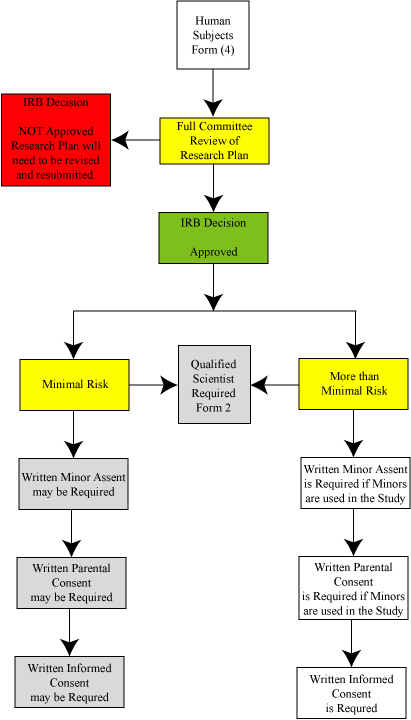
Form 4 – Human Participants
This form is used to document Institutional Review Board (IRB) approval of the student’s proposed research using human test subjects (see the ISEF rules & guidelines for more information on human subject research projects) and must be completed PRIOR to experimentation.
The Research Plan for a project using Human Subjects must include all of the following (much of this information can be transcribed directly onto the Informed Consent Form):
- Subjects: Describe who will participate in the study (age range, gender, racial/ethnic composition). Identify any vulnerable populations (minors, pregnant women, prisoners, mentally disabled or economically disadvantaged) that might be a target population.
- Recruitment: Where will you find your subjects? How will they be invited to participate?
- Methods: What will participants be asked to do (be specific!)? Will you use any surveys, questionnaires or tests? What is the frequency and length of the time involved for each subject?
- Risks: What are the risks or potential discomforts (physical, psychological, time involved, social, legal, etc.) to the participants? How will you minimize those potential risks?
- Benefits: List any benefits to society or individual participants.
- Protection of Privacy: Will any identifiable information (i.e., names, phone numbers, birth dates, email addresses, ages, etc.) be collected? Will data be confidential or anonymous (confidential means that the information collected will only be accessible to the Student Researcher and Adult Sponsor; anonymous means that there is absolutely no way that anyone can link a person’s participation in the project to the data gathered)? How will confidentiality or anonymity be maintained?
- Informed Consent Process: Describe how you will inform participants about the purpose of the study, what they will be asked to do, that their participation is voluntary, and they have the right to stop at any time.
**NOTE** Neither the Adult Sponsor, parent(s), Qualified Scientist, not the Designated Supervisor who oversees a specific project is permitted to serve on the IRB reviewing that project. This eliminates any conflict of interest.
For additional help in completing Form 4, watch the Form 4 Help Video.
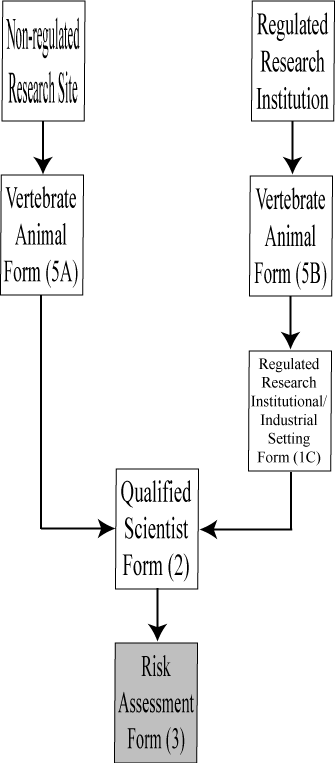
Form 5A/5B – Vertebrate Animal
These forms are used to document the Scientific Review Committee (SRC) approval of a student’s proposed research using vertebrate animals (see the ISEF rules & guidelines for more information on vertebrate animal research). Form 5A is used when the study is conducted at a home, school or field setting. Form 5B is used when the study is conducted at a regulated research institution and must be accompanied by that institution’s IACUC documentation.
The Research Plan for a project using Vertebrate Animals must include all of the following (much of this information can be transcribed directly onto Form 5A/5B):
- A discussion of potential alternatives to the use of vertebrate animals and detailed justification as to why vertebrate animals must be used.
- An explanation of the potential impact or contribution this research may have.
- Detailed procedures to be used, including methods used to minimize potential discomfort, distress, pain and/or injury to the animals during the course of experimentation and detailed chemical concentrations and drug dosages if applicable.
- Detailed number of animals being used, the species, strain, sex, age, etc. including justification for the number of animals planned for the research.
- Description of the housing and oversight of daily care.
- Discussion about the disposition of the animals at the termination of the study.
For additional help in completing these forms, watch the Form 5A Help Video or the Form 5B Help Video.
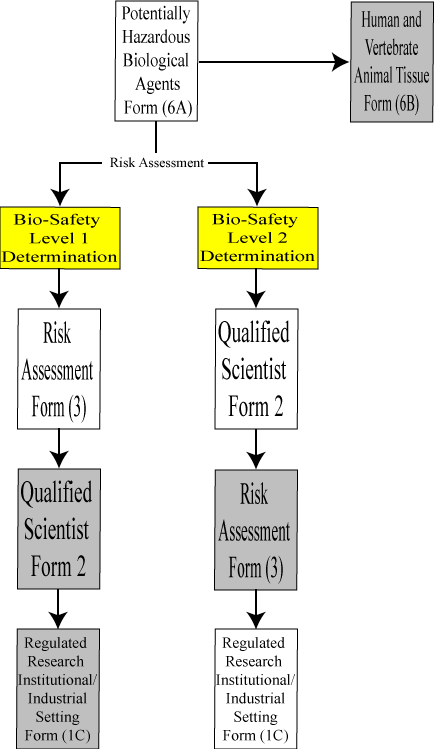
Form 6A – Potentially Hazardous Biological Agents Risk Assessment
This form is used to document the potential risks associated with any hazardous biological agents (including unknown bacteria collected from the environment) as well as the Scientific Review approval of the proposed research plan (see the ISEF rules & guidelines for more information on hazardous biological agent research).
Students must work with their Adult Sponsor or Designated Supervisor to assign a BioSafety Level to the research being proposed. These are the definitions for each BSL:
- BSL-1 risk group contains biological agents that pose a low risk to personnel and the environment. These agents are highly unlikely to cause disease in healthy lab workers, animals or plants. These agents require a BioSafety Level 1 containment. Examples of BSL-1 organisms include Agrobacterium tumefaciens, Micrococcus leuteus, Neurospora crassa, Bacillus subtilis.
- BSL-2 risk group contains biological agents that pose moderate risk to personnel and the environment. If exposure occurs in a lab situation, the risk of spread is limited, and it would rarely cause infection that would lead to serious disease. These agents require a BioSafety Level 2 containment. Examples of BSL-2 organisms include Mycobacterium, Streptococcus pneumoniae, Salmonella choloerasuis.
- BSL-3 risk group contains biological agents that usually cause serious disease or that can result in serios economic consequences. Projects in the BSL-3 group are prohibited.
- BSL-4 risk group contains biological agents that usually produce very serious disease that are often untreatable. Projects in the BSL-4 group are prohibited,
Form 6B – Human & Vertebrate Animal Tissue
This form is used to document the type and source of tissue(s) being used in the student’s project. All tissue studies must complete BOTH Form 6A and 6B prior to experimentation.
For additional help in completing these forms watch the Form 6A Help Video or Form 6B Help Video.
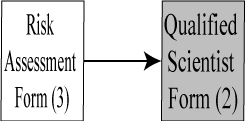
Form 3 – Risk Assessment
While not always required according to the ISEF rules, we recommend that ALL students complete a Risk Assessment Form 3 as a precaution prior to experimentation. Hazards (see the ISEF rules & guidelines for more information on hazardous chemicals, activities and devices) include, but are not limited to:
- chemicals (laboratory AND household)
- alcohol and tobacco
- prescription drugs
- drones
- 3D printers
- tools (manual and electric)
- heating devices (including ovens and stoves)
- excessive computer usage
- firearms and explosives.
**NOTE** There are certain chemicals that are banned for use in Colorado schools.
**NOTE** Students should reference the Materials Data Sheets for ALL chemicals used – these can give important information that is needed to complete the Form 3.
**NOTE** The Designated Supervisor MUST explain how they are qualified to supervise the use of whatever hazards are listed in the Riska Assessment – being Mom or Dad is not a qualification.
For additional help in completing this form, watch the Form 3 Help Video.
Below are links to the requirements for middle school students ONLY (do not mix with ISEF forms). You can also download the complete Middle School Rules & Guidelines Booklet.
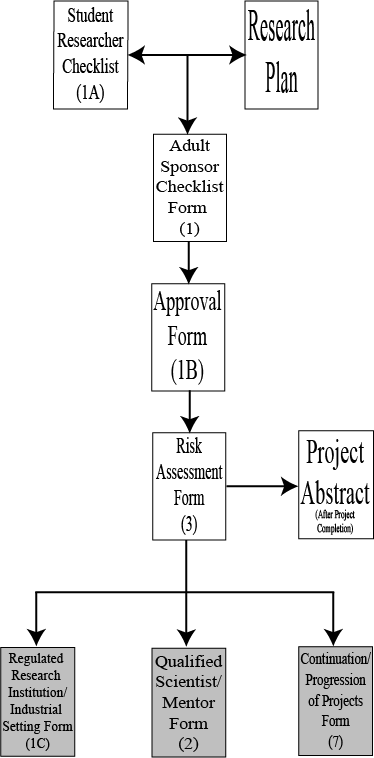
Form 1 – Checklist for Adult Sponsor
This form should be done once the Student Checklist (1A) and Research Plan are near completion. Please note that the Adult Sponsor should sign and date this form according to the date of REVIEW and APPROVAL and not the date of signature. This is useful if the students have research notebooks and the teacher reviews and initials those before transferring everything to the forms.
Form 1A – Student Checklist
This form should be completed in conjunction with the Research Plan. On this form, students should outline details about when and where the experimentation will take place.
**NOTE** If a student wishes to continue collecting data between competitions (i.e., after the Regional Science Fair and before CSEF), then a research amendment form should be completed indicating a new anticipated end date.
Research Plan
This should be typed and completed in conjunction with the Student Checklist Form (1A). It must be a detailed account of what the student(s) anticipate doing in the experimental portion of the project.
Any project dealing with Human Subjects, Vertebrate Animals and/or Potentially Hazardous Biological Agents (i.e. microorganisms, bacteria, etc.) MUST be reviewed by an Institutional Review Board and/or Scientific Review Committee prior to any experimentation beginning.
Form 1B – Approval Form
This form should be completed once the Student Checklist, Research Plan, Checklist for Adult Sponsor, Risk Assessment and any other needed forms for the type of project are all completed. Sections 1 & 2a (if applicable) must be signed prior to experimentation. Sections 3 & 2b (if applicable) will be signed just prior to a student competing in a regional science fair.
Form 3 – Risk Assessment Form
The CSEF requires all students using the Middle School forms to complete a Risk Assessment Form 3 that outlines the potential risks and hazards that might be associated with the project as well as assign an adult who will DIRECTLY supervise the student while they are working on their project. Please note that a student can have more than one Designated Supervisor, but they must complete separate Form 3s to outline what they are helping with. ALL sections MUST be completed with details about how the student is going to be safe while working on the project.
This form should be completed in conjunction with the Research Plan and is a review of the risks that MIGHT be associated with the project (see the CSEF rules & guidelines for more information on potential risks and hazards a student might encounter in their research) and must be completed PRIOR to experimentation.
**NOTE** There are certain chemicals that are banned for use in Colorado schools.
**NOTE** Students should reference the Materials Data Sheets for ALL chemicals used – these can give important information that is needed to complete the Form 3.
**NOTE** The Designated Supervisor MUST explain how they are qualified to supervise the use of whatever hazards are listed in the Riska Assessment – being Mom or Dad is not a qualification.
Form 1C – Regulated Research Institutional/Industrial Setting
This form is completed AFTER experimentation is done and is a summary of what the Student Researcher did at a professional lab or industrial setting. This is to be completed by the supervising adult who is affiliated with the laboratory and who has first-hand knowledge of the student’s work.
Form 2 – Qualified Scientist
This form is completed PRIOR to experimentation and is used to document when a Student Researcher works with a mentor who is a professional in the area of their project. A Qualified Scientist should have the following qualifications:
- Earned a doctorate/professional degree in a scientific field related to the student’s area of research AND/OR
- Has extensive experience and expertise in the student’s area of research.
- Be thoroughly familiar with the regulations that govern the student’s area of research including all local, state and federal regulations and laws.
- Can also serve as the Adult Sponsor, if they meet both sets of qualifications.
- May live elsewhere and not be local to the student, in which case, a Designated Supervisor must be appointed and trained to serve as the onsite supervision as necessary.
Form 7 – Continuation/Research Progression Projects Form
Any project that is based on the student’s prior research could be considered a continuation/research progression project. This form documents that the additional research is a significant expansion from prior work and is completed AFTER experimentation.
Repetition of previous experimentation with the same procedures and research question, even with an increased sample size, is an example of an unacceptable continuation.

Form 4 – Human Participants
This form is used to document Institutional Review Board (IRB) approval of the student’s proposed research using human test subjects (see the CSEF rules & guidelines for more information on human subject research projects) and must be completed PRIOR to experimentation.
The Research Plan for a project using Human Subjects must include all of the following (much of this information can be transcribed directly onto the Informed Consent Form):
- Subjects: Describe who will participate in the study (age range, gender, racial/ethnic composition). Identify any vulnerable populations (minors, pregnant women, prisoners, mentally disabled or economically disadvantaged) that might be a target population.
- Recruitment: Where will you find your subjects? How will they be invited to participate?
- Methods: What will participants be asked to do (be specific!)? Will you use any surveys, questionnaires or tests? What is the frequency and length of the time involved for each subject?
- Risks: What are the risks or potential discomforts (physical, psychological, time involved, social, legal, etc.) to the participants? How will you minimize those potential risks?
- Benefits: List any benefits to society or individual participants.
- Protection of Privacy: Will any identifiable information (i.e., names, phone numbers, birth dates, email addresses, ages, etc.) be collected? Will data be confidential or anonymous (confidential means that the information collected will only be accessible to the Student Researcher and Adult Sponsor; anonymous means that there is absolutely no way that anyone can link a person’s participation in the project to the data gathered)? How will confidentiality or anonymity be maintained?
- Informed Consent Process: Describe how you will inform participants about the purpose of the study, what they will be asked to do, that their participation is voluntary, and they have the right to stop at any time.

Form 5A/5B – Vertebrate Animal
These forms are used to document the Scientific Review Committee (SRC) approval of a student’s proposed research using vertebrate animals (see the CSEF rules & guidelines for more information on vertebrate animal research). Form 5A is used when the study is conducted at a home, school or field setting. Form 5B is used when the study is conducted at a regulated research institution and must be accompanied by that institution’s IACUC documentation.
The Research Plan for a project using Vertebrate Animals must include all of the following (much of this information can be transcribed directly onto Form 5A/5B):
- A discussion of potential alternatives to the use of vertebrate animals and detailed justification as to why vertebrate animals must be used.
- An explanation of the potential impact or contribution this research may have.
- Detailed procedures to be used, including methods used to minimize potential discomfort, distress, pain and/or injury to the animals during the course of experimentation and detailed chemical concentrations and drug dosages if applicable.
- Detailed number of animals being used, the species, strain, sex, age, etc. including justification for the number of animals planned for the research.
- Description of the housing and oversight of daily care.
- Discussion about the disposition of the animals at the termination of the study.

Form 6A – Potentially Hazardous Biological Agents Risk Assessment
This form is used to document the potential risks associated with any hazardous biological agents (including unknown bacteria collected from the environment) as well as the Scientific Review approval of the proposed research plan (see the CSEF rules & guidelines for more information on hazardous biological agent research).
Students must work with their Adult Sponsor or Designated Supervisor to assign a BioSafety Level to the research being proposed. These are the definitions for each BSL:
- BSL-1 risk group contains biological agents that pose a low risk to personnel and the environment. These agents are highly unlikely to cause disease in healthy lab workers, animals or plants. These agents require a BioSafety Level 1 containment. Examples of BSL-1 organisms include Agrobacterium tumefaciens, Micrococcus leuteus, Neurospora crassa, Bacillus subtilis.
- BSL-2 risk group contains biological agents that pose moderate risk to personnel and the environment. If exposure occurs in a lab situation, the risk of spread is limited, and it would rarely cause infection that would lead to serious disease. These agents require a BioSafety Level 2 containment. Examples of BSL-2 organisms include Mycobacterium, Streptococcus pneumoniae, Salmonella choloerasuis.
- BSL-3 risk group contains biological agents that usually cause serious disease or that can result in serios economic consequences. Projects in the BSL-3 group are prohibited.
- BSL-4 risk group contains biological agents that usually produce very serious disease that are often untreatable. Projects in the BSL-4 group are prohibited,
Form 6B – Human & Vertebrate Animal Tissue
This form is used to document the type and source of tissue(s) being used in the student’s project. All tissue studies must complete BOTH Form 6A and 6B prior to experimentation (see the CSEF rules & guidelines for more information on tissue research).
Once chosen to represent a Regional Science Fair at the CSEF, each STUDENT finalist must:
- choose a CSEF category to compete in (please note that category judging captains will review abstracts prior to CSEF to comply with the CSEF Category Change Policy (pdf) and will make recommendations for category changes accordingly); and
- register for the CSEF using the Colorado Science & Engineering Fair Student Registration Form (opens in a new window) – ONLY students who have won the right to represent their regional science fair and have received an official CSEF Finalist Flier from their Regional Fair Director are to use this registration form; and
- complete the official CSEF abstract (for individual or team projects), verify your email to officially submit the form, print TWO (2) copies from the email you receive once it has been submitted (one to send to the CSEF and one to keep with your project to display during the CSEF) AND sign both copies; and
- pay the $40/student registration fee via check (mail to CSEF; PO Box 1465; Fort Collins, CO 80522) or Venmo (@Courtney-Butler-114) by April 1st; and
- submit a copy of the CSEF Finalist’s Permission Form (signed), a copy of the official CSEF Abstract Form (signed), all required ISEF or CSEF paperwork (see Forms, Rules & Guidelines for more information) to the Regional Fair Director for them to forward on to the CSEF; and
- submit your digital project materials in Symposium.
NOTE: Each Regional Science Fair has its own personalized registration deadline at which point, all students’ paperwork, abstract submissions and registrations MUST be turned in to the CSEF Director. Check the Finalist Handbook, page 4 for details.
The Colorado Science & Engineering Fair has decided to continue requiring students to submit digital project materials as part of their registration process. This allows judges more time and freedom to review each student’s work before the day of judging interviews and it opens up the students’ projects to a much wider audience than those in the immediate Fort Collins area. We have purposefully eliminated any time for the Special Awards Judges to see project boards the day of judging and Grand Awards Judges have never had enough time to do a thorough job.
This is your chance to convey what you did with your project with more than just a written abstract.
We have prepared templates for the various types of projects presented at the CSEF – please feel free to modify them as needed up to 12 pages.
- Science Project Presentations:
- Engineering Project Presentations:
- Mathematics/Computer Science Project Presentations:
Along with your digital presentation, you must have a physical project board to display at the CSEF. All presentations must follow the display & safety regulations outlined in the Finalist Handbook (pages 14-15). The following are a few items that are typical problems found during the Display & Safety Inspections at CSEF:
- ALL items you want to present to the judges MUST fit within the allotted volume of 9′ high, 4′ wide and 30″ deep. NOTHING can be set in front of the table as part of the project display.
- Students must have their signed official CSEF Abstract Form (with logo), Form 1C for work done at a regulated research institution or industrial setting (if applicable), and Form 7 for continuation/progress projects (if applicable) at their project.
- ALL photographs, images, graphics, data tables, graphs, etc. must be INDIVIDUALLY credited (even if everything was done by the student). Items from the internet must have the specific URL for that image (do not credit Google Images).
- No glass or glass objects are allowed at the display (this includes equipment used during experimentation).
- No live or dried plant material is allowed at the display.
- No food is allowed as part of the display (do not glue food items to your board as we will make you take them off).
- No liquids (other than water for consumption by the student) are allowed as part of the display.
- No laser pointers are allowed to be used during judging.
- No sharp objects may be part of the display.
- Acknowledgements of any kind must be in an identified area of the project board.
Failure to follow these display & safety guidelines may result in disqualification from the CSEF.
The following are digital publications that students, teachers and parents might find useful:
- The CSEF Middle School Rules & Guidelines (pdf) is an option for only 6th – 8th grade students to use instead of the Regeneron ISEF forms. If a student uses these rules and forms, they must follow ALL of the rules for middle school students and not pick and choose between the ISEF forms and these.
- The CSEF Finalist Handbook (pdf) includes the necessary information for students who have qualified to compete at the CSEF by their Regional Science Fair.
- The 2023 CSEF Program (pdf) includes all of the Finalists’ project information and programmatic information for the days of the science fair.
- The 2023 CSEF Awards Ceremony Program (pdf) includes information on the organizations that provide the special awards.
Detailed schedules and information on the following activities can be found in the Finalist’s Handbook (pages 10 – 13). All activities (except where noted) will be held in the Lory Student Center (LSC) on the Colorado State University – Fort Collins campus.
- Scientific Review Committee Interviews (by invitation only) will be held via Zoom 2 weeks prior to the CSEF.
- Digital Project Presentations must be submitted in pdf format to Symposium by March 27th.
- Display Inspections of the digital project presentations will take place immediately following the submission deadline and corrections must be made by the Sunday prior to the CSEF or the project presentation will not be made available to the judges.
- Pre-Interview Project Reviews will take place in Symposium during the week leading up to the CSEF.
- Display & Safety Inspections of physical project materials and Official Photos will take place in the LSC Grand Ballroom on Thursday of the CSEF between 9 a.m. and 12 p.m.
- Grand Award Judging Interviews will be conducted on the Thursday of CSEF from 12:45 p.m. to 4:30 p.m.
- Special Award Judging Interviews will be conducted on the Thursday of CSEF from 1:30 p.m. to 5:00 p.m.
- Student Choice and Poster Art Contest balloting will take place on the Friday of CSEF and are due at the CSEF Registration Booth by 2:00 p.m.
- The Guest Speaker presentation will take place on Friday of the CSEF in the LSC Theater at 9:00 a.m.
- CSU Tours and Presentations will be held in various campus locations (leaving from the LSC) on Friday of the CSEF between 11:00 a.m. and 3:00 p.m. Pre-registration for tours will open sometime the week of March 10.
- CSEF will be Open to the Public on Friday of the CSEF from 10:00 a.m. to 5:00 p.m. and on Saturday of the CSEF from 9 a.m. to 11 a.m. (students are required to be at their projects during this time) in the LSC Grand Ballroom.
- Awards Ceremony will take place on Friday of the CSEF at Timberline Church beginning at 6:00 p.m. (doors open at 5:30 p.m.).
- Pizza Party will take place on Saturday of the CSEF outside of the LSC Grand Ballroom starting at 11 a.m.
- Project Teardown may begin at 11 a.m. on Saturday of the CSEF. All projects must be taken down by 1 p.m.
As an incentive to participate and to reward outstanding research, the CSEF offers many different types of awards to the student entered into the CSEF each year. Some of these students must opt into to be eligible.
- Grand Awards of 1st, 2nd 3rd and Honorable Mention are awardedin each of the 12 categories for both the Junior (6-8 grades) and Senior (9-12 grades) Divisions.
- Student Choice Awards of a special memento, certificate and $100 are given in both the Junior and Senior Divisions. Finalists vote for their favorite projects (ballots are due by 2:00 p.m. on Friday of the CSEF).
- A Poster Art Contest (pdf) is held where any student in Colorado may submit an entry for the next year’s artwork for the Finalists to vote on. The winner receives a certificate and $100. The winning artwork will be printed on the covers of the next year’s CSEF publications and be used as inspiration for the t-shirt design.
- Technical Writing Awards (pdf) are available to students in both the Junior (Elemer Bernath Memorial award) and Senior (Ralph Desch Memorial award) Divisions. To be considered for this award, students must prepare a technical report as if they were planning on being published in a scientific or technical journal. The winners receive a certificate, $100 and his/her work published on the CSEF website.
- Pioneers of Science Awards are sponsored by individual Board of Directors members and the winners are chosen based on their enthusiasm for their project and their future potential as a scientist/engineer. Each winner receives a certificate, information on the pioneer of science the award is named for and $50.
- Special Awards and Scholarships are provided by a variety of scientific organizations, businesses, universities and individuals according to criteria that they set. Check out the latest list of Special Award Organizations along with the criteria for the award and which CSEF categories are eligible for the award.
Nominate your teacher for the CSEF Teacher of the Year award sponsored by Lockheed Martin! Nominations for the 2025 CSEF will be accepted until March 1st. Check out the CSEF Teacher Hall of Fame!
